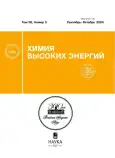Фотоокисление виологенами тиакарбоцианиновых красителей и их супрамолекулярных комплексов с кукурбит[8]урилом
- Авторы: Захарова Г.В.1, Федотова Т.В.1, Чибисов А.К.1
-
Учреждения:
- “Национальный исследовательский центр “Курчатовский институт”
- Выпуск: Том 58, № 5 (2024)
- Страницы: 379-384
- Раздел: ФОТОХИМИЯ
- URL: https://pediatria.orscience.ru/0023-1193/article/view/684844
- DOI: https://doi.org/10.31857/S0023119324050053
- EDN: https://elibrary.ru/TXUVIA
- ID: 684844
Цитировать
Полный текст
Аннотация
Исследована реакция фотоокисления 3,3’-диэтил-9–метилтиакарбоцианина и 3,3’-диэтилтиакарбоцианина виологенами (метилвиологен, п-хлорфенилвиологен, п-цианфенилвиологен) в ацетонитриле и их димерных комплексов с кукурбит[8]урилом мономерными комплексами виологенов с кукурбит[8]урилом в воде. Продуктами фотоокисления мономеров красителей в ацетонитриле являются дикатион-радикалы красителей и катион-радикалы виологенов. При фотоокислении димерных комплексов образуются трикатион-радикалы димерных комплексов и катион-радикалы мономерных комплексов виологенов. Наиболее эффективно протекает реакция фотоокисления красителей в ацетонитриле.
Полный текст
Об авторах
Г. В. Захарова
“Национальный исследовательский центр “Курчатовский институт”
Автор, ответственный за переписку.
Email: gvzakharova@gmail.com
Курчатовский комплекс “Кристаллография и фотоника”, отделение “Центр фотохимии”
Россия, МоскваТ. В. Федотова
“Национальный исследовательский центр “Курчатовский институт”
Email: tatyana.fedotova@phystech.edu
Курчатовский комплекс “Кристаллография и фотоника”, отделение “Центр фотохимии”
Россия, МоскваА. К. Чибисов
“Национальный исследовательский центр “Курчатовский институт”
Email: alexander.chibisov@gmail.com
Курчатовский комплекс “Кристаллография и фотоника”, отделение “Центр фотохимии”
Россия, МоскваСписок литературы
- Джеймс Т. Теория фотографического процесса, 4–е издание, Л.: Химия, 1980. 672 с.
- Качковский А.Д. Строение и цвет полиметиновых красителей, Киев: Наукова Думка, 1989. 231 с.
- Шапиро Б.И. // Успехи химии. 2006. Т. 75. № 5. С. 484.
- Чибисов А.К., Алфимов М.В., Захарова Г.В., Атабекян Л.С., Авакян В.Г., Плотников В.Г. // Химия высоких энергий. 2017. Т. 51. № 6. С. 480.
- Чибисов А.К., Алфимов М.В., Захарова Г.В., Авакян В.Г., Федотова Т.В., Гутров В.Н. // Изв. АН. Сер. хим. 2022. № 2. С. 199.
- Чибисов А.К., Славнова Т.Д., Гёрнер Х. // Российские нанотехнологии. 2008. Т. 3. № 1. С. 26.
- Федотова Т.В., Захарова Г.В., Чибисов А.К. // Оптика и спектр. 2022. Т. 130. Вып. 5. С. 675.
- Jeon W.S., Kim H-J., Lee C., Kim K. // Chem. Commun. 2002. P. 1829.
- Biedermfnn F., Scherman A. // J. Phys. Chem. B. 2012. V. 116. P. 2842.
- Атабекян Л.С., Чибисов А.К. // Химия высоких энергий. 2007. Т. 41. № 2. С. 122.
- Альперович М.А., Лифшиц Э.Б. // Успехи научн. фотогр. 1989. Т. 25. С. 51.
- Савин В.М., Чибисов А.К. // Химия высоких энергий. 1989. Т. 8. № 5. С. 584.
Дополнительные файлы















